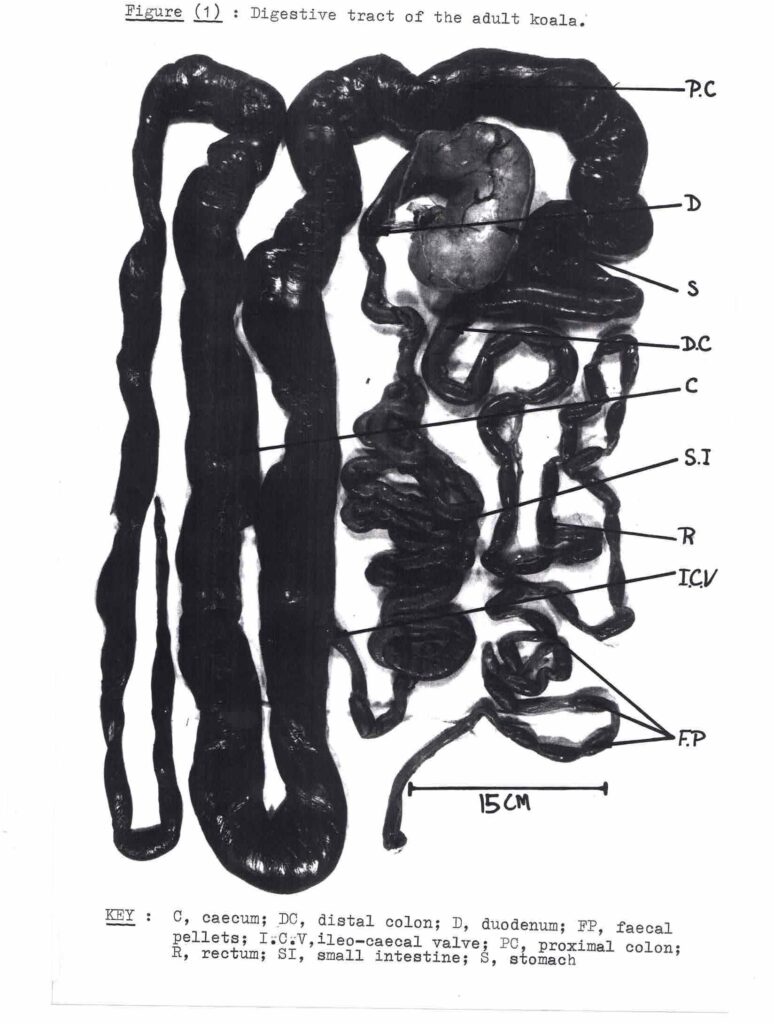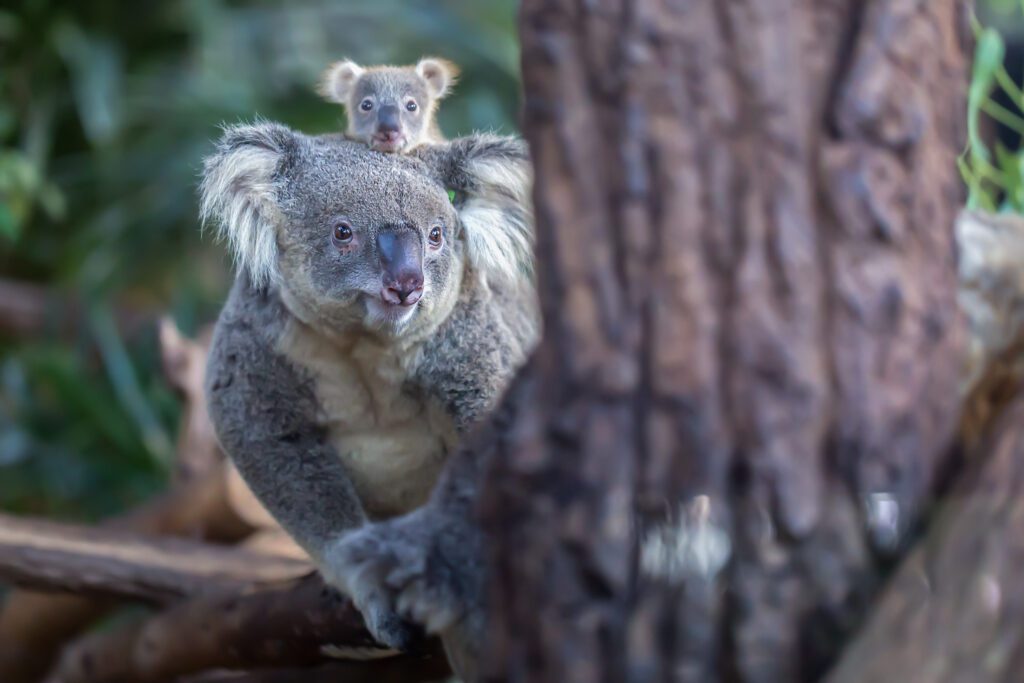It is hard to believe their caecum is longer than most people can jump; 2 meters.
But what does it do? That was the question.
The Early years
I had spent just over a year looking at koala poo samples, trying to develop reliable methods for growing the bacteria from the caecum. After getting my Honors, I was ready to move on to my Master’s to take a deeper look at the bacteria that called this unique organ home.
I developed special media, including Eucalyptus extracts, to grow the bacteria I had isolated, trying to maintain similar growth conditions to those found in the caecum.
It was time to actually look at samples from the caecum. Dead animals were unreliable after about 4–5 hours because the environment and the microflora changes.
What does this caecum do?
Anecdotal references indicated that sailors tried to keep koalas alive (to take them back to Europe) with biscuits soaked in Eucalyptus oil. Perhaps not surprisingly, they did not survive.
Koalas can only be found outside Australia in zoos that go to the trouble of growing a Eucalyptus plantation to feed the koalas.
Scientists had assumed that, like other animals with a caecum, such as mice, rabbits, and horses, this chamber was a retention organ for food. At the same time, bacteria decomposed the food to provide nutrition.
Breaking down complex carbohydrates (such as in the leaves) takes time, and normal passage times through the intestine would not accommodate this.
Indications from other animals have shown that the caecum could also be involved in nitrogen or vitamin recycling and even play protective roles against toxic compounds.
The Case of the Koala
All of these would apply to the koala when you consider the following:
** Eucalyptus leaves are predominantly water (34–40%) and carbohydrates (37–42%). Their nutritional value is estimated to be 55–60%.
** Koalas don’t drink but get all their moisture, such as dew or rain, from the leaves (45–58%) and only (29–42%) from the breakdown of food.
** Eucalyptus oils, such as those found in the leaves, are quite toxic. Ingestion of Eucalyptus oils by humans can lead to severe throat, stomach, and intestinal irritation and weakening of the heart, which can eventually lead to death.
Therefore, the koala must either be immune to these effects or detoxify the oils somehow and perhaps this is what the bacteria in the caecum do.
The Magic Sauce
Despite all these theories, and whatever it does, the gut flora of the koala is very important. So important that the mother produces a ‘magic sauce’ called pap from her anus that is eaten by the joey just before leaving the pouch to start on Eucalyptus leaves.
Without going into detail, the process of emptying her bowel in preparation and how this is actually transferred from the caecum, which has poor muscles, is one of those freaks of nature.
Scientists postulated that pap must colonize the joey with important bacteria to aid in digesting the Eucalyptus leaves.
In some way, the bacteria must be very special for evolution to go through all this trouble.
Moving away from poo
The solution to looking at the bacteria in the caecum came from using what is called ‘road kill’ animals.
Unfortunately, many koalas are maimed or seriously injured by cars on country roads.
Although koalas are expert climbers, they are clumsy when walking and have difficulty crossing roads. (Over 4000 are killed each year by cars and dogs).
I gained a special permit for the Victorian Fisheries and Wildlife to use animals that had been freshly euthanized because of their extensive injuries as specimens.
Purely by chance, the first koala was a mother with a young 7–8-month-old Joey. This gave me a great opportunity to look at what was in a juvenile koala that had probably only recently had the ‘Magic sauce.’
Getting some insight into what was in the ‘magic sauce’, was like winning lotto!
Quid Pro Quo
In exchange for the license, I assisted Fisheries Officers in relocating koalas from koala-rich places in Victoria to other parts of the country. This was a wonderful experience. So here is my question for you:
How do you get a koala down a tree?
Answer: You wave a piece of bright material above their head.
For some reason, it spooks them, and they start to climb down within range of officers to then put a lasso around them and guide them down.
Koalas on the ground that have just been removed from their tree are not to be messed with. They tend to get a bit upset (and why not?) They (especially the males) stand on their back feet, put their arms out, and grunt at you!
The trick is to stay clear of their claws. One poor officer who had just put a koala into its crate left his hand on the side of the crate too long, and the koala’s claws pierced right through his hand. Accidental, but it did some damage.
Many years later, I have come to realize it was these side experiences that made my post-graduate studies memorable.
A Look at the Caecum
The layout of the adult koala intestine is shown below.

The adult caecum constitutes 26% of the total digestive tract. This is much bigger than any other animal with a caecum. By comparison, the caecum of the juvenile (who became known as ‘Charlie’) was only 13%.
The disproportionate increase in the proportion of the caecum indicates that its growth is in response to the change in diet and the corresponding need for a specific function.
In the next episode, I recount the double whammy that cost me six months of research time and nearly made me give up.
You Can Help:
I am writing this series in the hope of raising some money, which I will contribute to the Australian Koala Foundation. If you want to make a donation, the best way is at Ko-fi. I love coffee (a donation is a cup of coffee). I don’t know if koalas do, but we can change it to Eucalyptus tea!!!!
Next Episode Part IV: Bite Me!
Till next time,
Calvin
Copyright © Calvin London 2024


